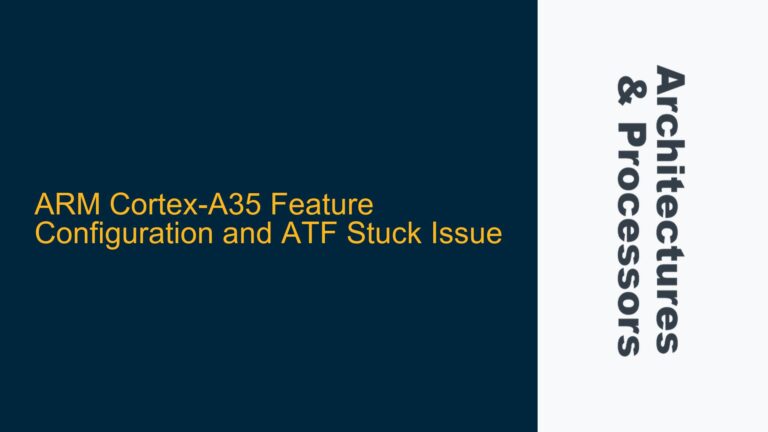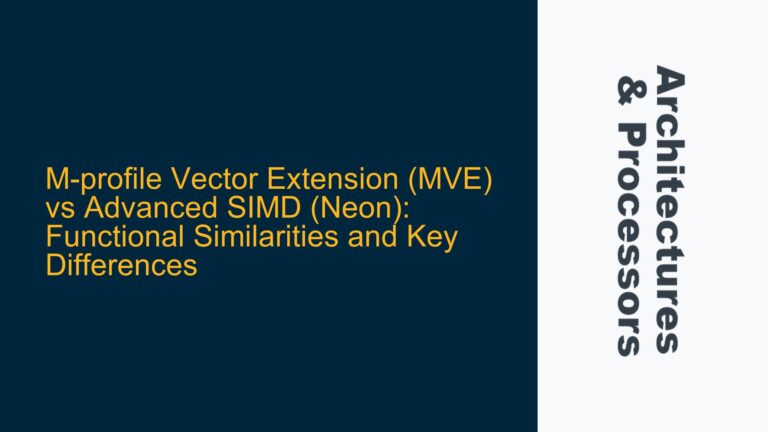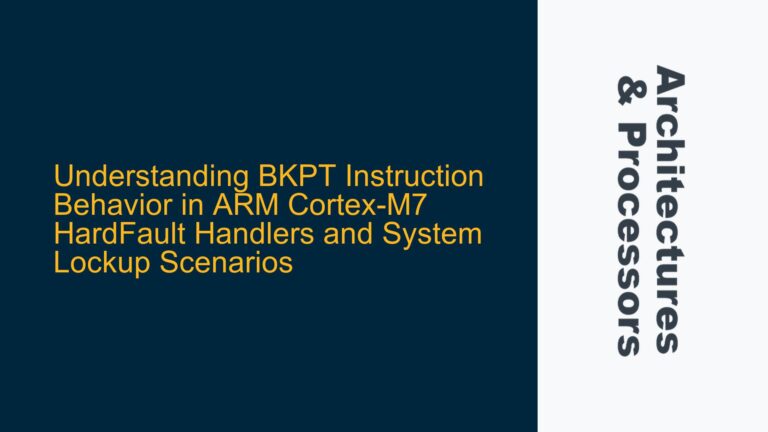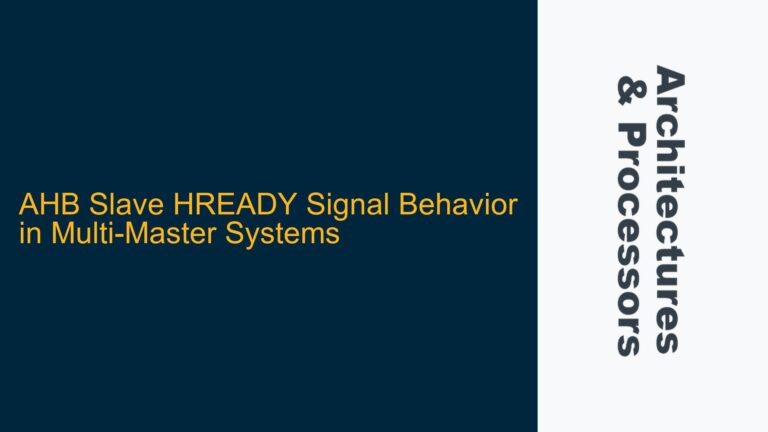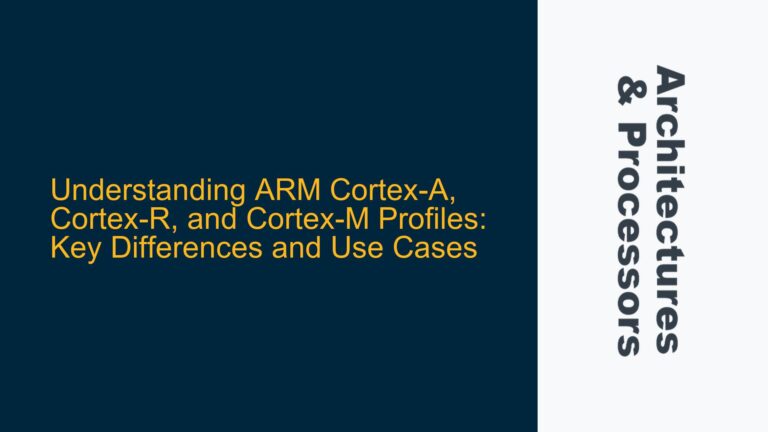ARM Cortex-M4 Pipeline Hazards and Data Dependency Handling
The ARM Cortex-M4 processor, like many modern microprocessors, employs a pipelined architecture to enhance performance by allowing multiple instructions to be processed simultaneously. However, this parallelism introduces the potential for data hazards, which occur when the outcome of one instruction depends on the result of a previous instruction that has not yet completed. These hazards are typically categorized into three types: Read After Write (RAW), Write After Read (WAR), and Write After Write (WAW).
In the context of the ARM Cortex-M4, the pipeline consists of several stages, including Fetch, Decode, Execute, Memory Access, and Writeback. Each stage processes a different instruction at any given time, and the processor must ensure that data dependencies are respected to maintain correct program execution. The Cortex-M4 handles these hazards through a combination of techniques, including forwarding (also known as bypassing), stalling, and instruction reordering.
Forwarding is a common technique used to mitigate RAW hazards. When an instruction in the Execute stage produces a result that is needed by a subsequent instruction in the Decode stage, the result is forwarded directly from the Execute stage to the Decode stage, bypassing the Writeback stage. This allows the dependent instruction to proceed without waiting for the previous instruction to complete the Writeback stage.
The Cortex-M4 also employs stalling to handle hazards that cannot be resolved through forwarding. When a hazard is detected, the pipeline is temporarily halted, allowing the necessary data to be computed and made available before proceeding. This ensures that instructions are executed in the correct order, preserving the integrity of the program.
In addition to these techniques, the Cortex-M4’s AHB (Advanced High-performance Bus) interface plays a crucial role in managing memory-related hazards. The AHB interface is designed to handle memory accesses in a strictly ordered manner, ensuring that all memory operations are completed in the sequence they appear in the program. This eliminates the possibility of WAR and WAW hazards in memory operations, as all writes and reads are guaranteed to occur in the correct order.
Memory Interface Ordering and Write Buffer Constraints
The ARM Cortex-M4’s memory interface is designed to maintain strict ordering of memory operations, which is critical for avoiding data hazards in memory-intensive applications. The AHB interface, which connects the processor to the memory subsystem, ensures that all memory accesses are completed in the order they are issued. This is particularly important for maintaining consistency in multi-threaded or multi-core environments, where out-of-order memory accesses could lead to unpredictable behavior.
The Cortex-M4’s write buffer is another key component in managing memory hazards. The write buffer is a single-entry buffer that temporarily holds data to be written to memory. Because the buffer can only hold one write operation at a time, all write operations are effectively serialized, ensuring that they are completed in the order they are issued. This design choice simplifies the memory interface and eliminates the need for complex out-of-order execution logic, which can be resource-intensive and power-hungry.
However, the single-entry write buffer also imposes certain limitations on the processor’s performance. Since only one write operation can be in progress at any given time, subsequent write operations must wait for the current write to complete before they can proceed. This can lead to pipeline stalls if multiple write operations are issued in quick succession, potentially impacting overall performance.
Despite these limitations, the Cortex-M4’s memory interface and write buffer design are well-suited for embedded applications, where power efficiency and simplicity are often more important than raw performance. By ensuring that all memory operations are completed in order, the Cortex-M4 avoids the complexity and power consumption associated with out-of-order execution, while still providing sufficient performance for most embedded tasks.
Investigating Power Consumption Anomalies in SBC and ORN Instructions
The observed power consumption anomalies in the SBC (Subtract with Carry) and ORN (Logical OR NOT) instructions on the ARM Cortex-M4 can be attributed to several factors, including pipeline stalls, data dependencies, and the specific implementation of these instructions in the processor’s microarchitecture.
In the provided examples, the power consumption of the Cortex-M4 varies depending on the sequence of instructions executed. Specifically, when consecutive SBC or ORN instructions have data dependencies (e.g., the result of one instruction is used as an operand in the next instruction), the power consumption is higher compared to sequences where the instructions are independent. This behavior can be explained by the processor’s handling of data hazards and the associated pipeline stalls.
When a data hazard is detected, the Cortex-M4 may stall the pipeline to ensure that the dependent instruction receives the correct data. During a stall, the processor continues to consume power, but no useful work is being done, leading to an increase in power consumption. In the case of the SBC and ORN instructions, the data dependencies between consecutive instructions may cause the pipeline to stall more frequently, resulting in higher power consumption.
Additionally, the specific implementation of the SBC and ORN instructions in the Cortex-M4’s microarchitecture may contribute to the observed power consumption differences. These instructions may require more complex logic or additional pipeline stages to execute, leading to higher power consumption compared to simpler arithmetic or logical instructions. The exact details of the microarchitecture are not publicly documented, but it is reasonable to assume that the SBC and ORN instructions have unique characteristics that affect their power consumption.
To further investigate these anomalies, it is important to consider the Hamming weight of the operands used in the instructions. The Hamming weight, which is the number of 1s in the binary representation of a value, can influence the power consumption of the processor due to the switching activity in the logic gates. However, in the provided examples, the Hamming weight of the operands is kept constant, suggesting that the observed power consumption differences are not due to variations in the operands but rather to the instruction sequences themselves.
In conclusion, the power consumption anomalies in the SBC and ORN instructions on the ARM Cortex-M4 are likely due to a combination of pipeline stalls caused by data dependencies and the specific implementation of these instructions in the processor’s microarchitecture. Understanding these factors is crucial for optimizing the performance and power efficiency of embedded systems based on the Cortex-M4 processor.

